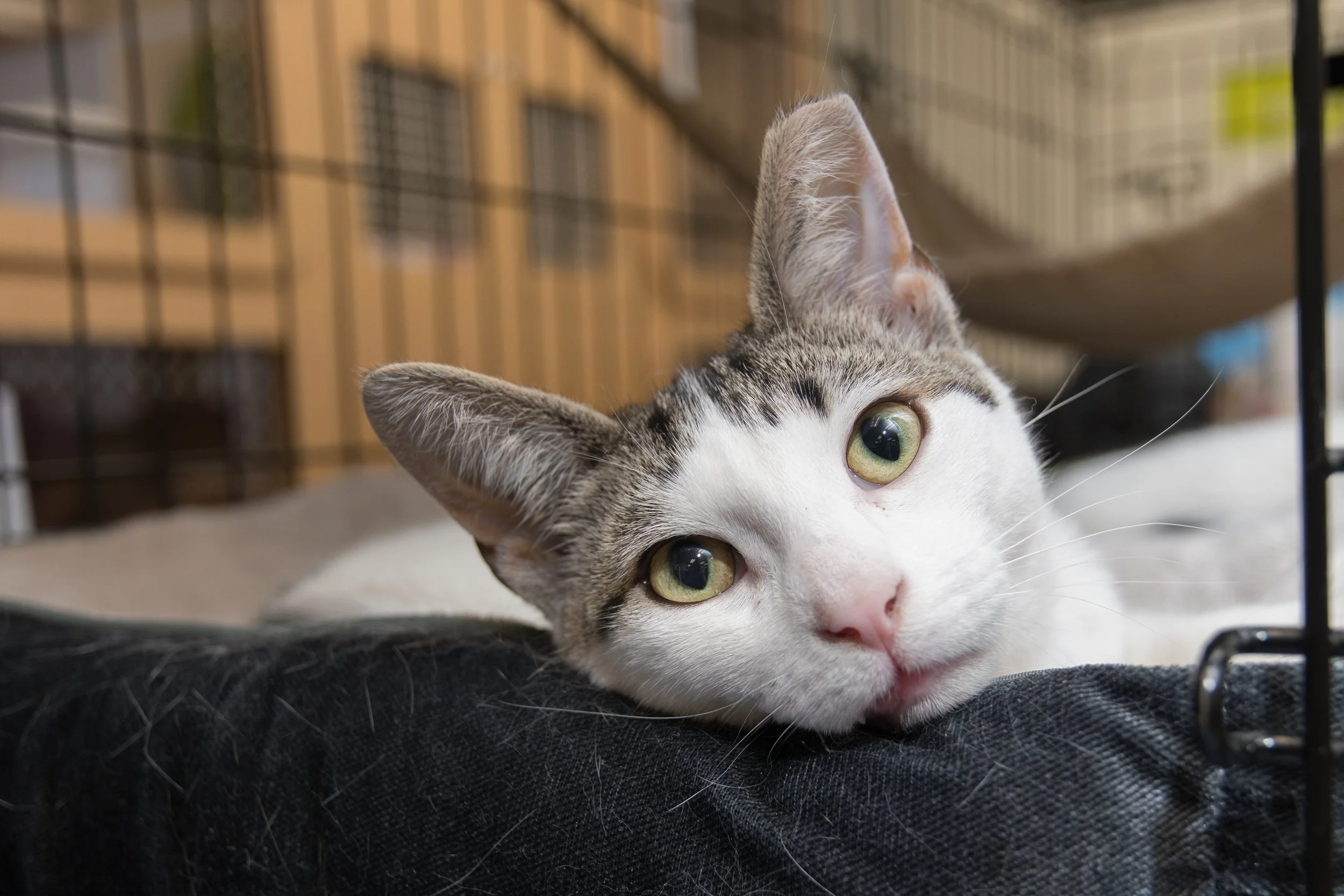
Before your new kitty arrives, ensure your home is a safe, welcoming space by taking a few key steps:
Windows & Doors
Make sure all windows are screened/secured and that any doors leading out of your home (backyard, balcony, hallway) are secure as well.
Breakables
Put away breakables until you get to know your cat better to avoid starting your relationship off with them accidentally breaking a cherished item.
Washer / Dryer
From now on, always check your washer & dryer (if you have one) before using it, to ensure your kitty hasn’t decided to take a nap inside.
Plants
Check that your houseplants are not toxic to cats. Toxic and Non-Toxic Plant List - Cats | ASPCA.
Cleaning Products & Medication
Be sure that any cleaning products, chemicals, medications, or supplements are locked away.
Ingesting pollen or petals from lilies can cause kidney failure.
Cat Proofing
Secure electric or blind cords and open trash bins. Block small spaces your cat shouldn’t get into (e.g. behind the stove). Things like string, yarn, thread, ribbon, and dental floss are very dangerous to cats so keep them out of reach. If they ingest, it can cause a serious medical issue.
Painkillers such as Tylenol or Aspirin are toxic to cats.
You’ve brought your new kitty home. Now what?
Below are some tips to help.
Space
Many cats need space to be alone and decompress when they first arrive. Resist the urge to try immediately to pet or engage with them. Remember, you have had time to prepare for this moment, they have not.
Patience
Don’t expect your cat to snuggle or play right away. Stress may cause them to hide, hiss, or even swat at first. Patience is one of the best gifts you can give them at this time. Once their fear subsides their personality will start to shine through.
Acceptance
One of the most satisfying parts of bringing home a new pet is learning who they really are. You may be surprised but, with time, you’ll probably love your cat more for their quirks and unexpected moments. Time will reveal your cat’s true personality and let you bond with them for who they are.
Create a Safe Space
Before bringing home a new cat, organize a “safe room” for them to stay in for the first few days. While you have been eagerly planning for your cat’s arrival, he or she didn’t expect the transition and now suddenly are in an unfamiliar space with new people.
Some cats take this in stride, but others need time to adjust. By giving your cat just a small space to explore at first, you help them settle into their new home. A bedroom, office, or spare bathroom can be a good place to set up your new cat’s safe space.
Include the essentials — food, water, litter box. Give them a covered bed where they can feel secure and be somewhat hidden. Add some toys for them to play with when they start to venture out.
Bonding and Socializing
Safe Space: Start them off in the safe space you created. They may stay in hiding for a few hours or even days. Check to make sure they are eating and using their litterbox.
Play: Interactive play is a very useful tool for bonding with your new cat. Play will calm an energetic cat and build confidence in a shyer cat. It also gives you and your cat a fun activity to do together. If your cat isn’t ready for pets yet, play will help them trust you.
Meals: Give your cat space during mealtimes. Don’t try to pet/touch them while they are eating.
Treats & Touch: For cats that are shy or uncertain about being touched, offer treats. As opposed to hands being a scary thing they’ll start to associate them with tasty treats.
Take it slow: If your cat is very frightened/actively avoiding you with play and treats, give them a bit more space and time to decompress and then try again.
Introducing another cat
The process of introduction could take a few hours or a few months. Follow the steps below to introduce your new feline family member to your resident cat.
Safe room: Keep your new cat separated from the resident cat in their safe room. Your cats will be able to hear and smell one another so can get used to each gradually.
Puzzle feeders/wand toys: Give your cats something fun to do on either side of the safe room door. This can be a puzzle feeder (for each) or playing with a wand toy (for each). Gradually crack the door (or put a plastic barrier up) so they get increased visual contact. Obviously, this is easier with two people.
Supervised meetings: Let your cats out together for supervised visits. Play with them and offer treats so they associate the experience with something positive.
Remember, don’t rush! Cat introductions can take time but going at slow pace will increase the likelihood that your new family members will develop a good relationship.
Supply checklist for a new cat
-
What do I feed? Buy high-quality wet food. Canned food is higher in protein and moisture which is healthier for cats.
How much? The amount of food a cat needs can vary widely depending on the type of food, the age of the cat, and the cat’s unique health needs. Growing kittens (up to 6 months) require more food to support their growth.
When? Feed adults 2x a day and kittens 3x a day. Get your cat on a feeding schedule. Free feeding can, over time, lead to weight gain.
Water: Always leave out a water dish and refresh it frequently. Option to also have a water fountain for consistent water flow.
-
Supplies: Check with the foster for any preference the cat may have in terms of litter type, box size/type. For large homes, consider temporarily adding additional boxes around the house that can later be phased out. This can be especially useful with kittens that may get so absorbed in play and exploration that they forget/put off using the box. If a litterbox is always nearby you are much less likely to have accidents.
Location: Choose a peaceful but easily accessible area to place your cat’s litter box where they won’t be startled while using it. If your cat feels unsafe in the area that you've provided, they may decide to use a place that they find more suitable.
Cleanliness: Scoop the litterbox at least once a day. If the litter box gets too dirty your cat may choose to go elsewhere. Ask yourself if you’d want to use a toilet that hadn’t been flushed in several days.
-
What size? The correct size carrier allows your cat to fully stand up and turn around. But don’t go too large. Leaving too much extra space can leave a cat feeling stressed and unsafe.
What type? Both hard (plastic) and soft (fabric) carriers can be a good option. Soft carriers are lighter and generally easier to carry. Hard carriers are heavier but easier to clean.
Security: For soft carriers, look for brands that offer a locking zipper feature. Otherwise, twist ties work well.
Set up: Place a pee pad or towel inside your carrier in case of accidents. When stressed, cats feel more secure in darkness so consider placing a towel over the carrier to block their view.
In transit: NEVER open the carrier while traveling. Cats can be masters of escape, especially when stressed. Don’t give them an opportunity to escape in an unsafe and unfamiliar place.
-
Importance: Cats are tiny little predators with the instinctual drive to hunt. Toys give them a way to channel that energy in a safe and non destructive way.
What to buy: There are many different types of toys you can purchase: cat tunnels, teaser wands, balls, food-dispensing toys, ball tracks, catnip toys, laser pointers, and mechanical toys. To start, get at least one interactive toy (wand toy) and a few balls, springs, or catnip mice.
Safety: Never leave wand toys out unattended. Your cat can get tangled up in the string. While images of cats playing with yarn are everywhere, know that this is not a safe item for your cat to play with. They can ingest the string or get tangled up in it.
-
Sleeping: A covered bed is often a good initial choice for your cat. As cats enjoy multiple sleeping spots, over time you may want to purchase more than one bed.
Scratching: Cats scratch to keep nails in check, stretch their muscles and mark territory. Cats can have preferences when it comes to angle and texture. Some prefer horizontal surfaces and others vertical. Some prefer sisal rope scratchers and others cardboard.
Exploring: Cats love to survey their territory from high up. Find ways to safely let your cat explore the vertical space in your apartment. To start, consider purchasing a cat tree.
-
Veterinary care: Identify a vet in your area in advance that you will bring your cat to for annual check-ups and should they become ill. Do your research and choose your cat’s doctor with the same diligence that you would choose your own.
Register your cat’s microchip so that your contact information can be found in the event you are separated from your pet.
Get pet insurance: Pet insurance can ensure that you never have to make a choice between money and your pet’s health or life because you can’t afford the care. A trip to the emergency room can cost thousands of dollars.
Find a pet sitter: Identify a reliable pet sitter to look after your cat should you need to go out of town.










